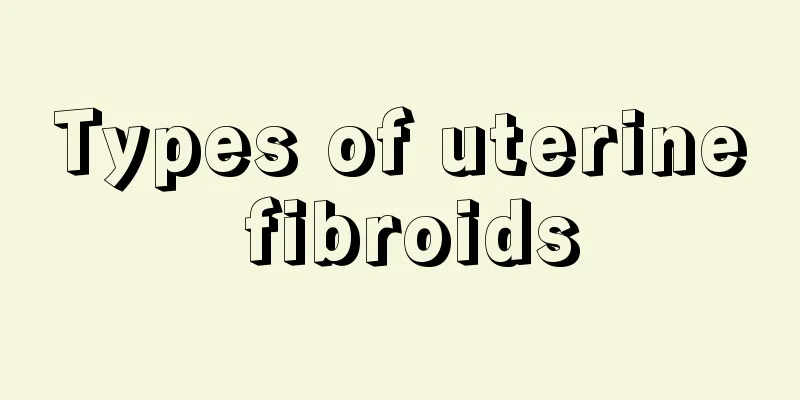Types of uterine fibroids

|
Uterine fibroids are a relatively common disease, but people do not take into account that uterine fibroids are divided into different types. Some uterine fibroids may become larger, while others may become smaller. This still depends on a person's physical condition. Uterine fibroids are also divided into three different stages of severity and urgency. Most of them are benign tumors, but they require regular early treatment when discovered. Diagnostic criteria for uterine fibroids 1. Excessive menstruation, prolonged menstruation or irregular bleeding, hard lumps in the lower abdomen, pain and pressure symptoms in a few cases, or accompanied by anemia. 2. The uterus is enlarged and hard. 3. Detect growth or deformation of the uterine cavity. 4. During the curettage, a convex surface was felt in the uterine cavity. 5. B-mode ultrasonography and/or hysteroscopy can assist in the diagnosis. Why do uterine fibroids cause infertility? Uterine fibroids are the most common solid benign tumors in the female reproductive tract. Uterine fibroids are formed by the proliferation of smooth muscle tissue. They are common in people aged 30 to 40. They can grow singly or in multiples and can vary in size. The cause of uterine fibroids is still unclear, but most people believe that it is related to excessive estrogen stimulation in the body. The incidence of infertility in patients with uterine fibroids is approximately 22% to 32%, among which submucosal fibroids have the highest incidence of infertility. Uterine fibroids can be divided into subserosal fibroids, intramural fibroids, submucosal fibroids, cervical fibroids, ligament fibroids, etc. according to their occurrence site. Generally, small or solitary subserosal and intramural uterine fibroids do not affect conception and pregnancy. Uterine fibroids may lead to infertility in the following situations: (1) Larger uterine fibroids can deform the uterine cavity, which is not conducive to the passage of sperm, implantation of the fertilized egg, and fetal development. (2) Fibroids growing near the uterine horns can compress the opening of the fallopian tubes, causing blockage. (3) Fibroids growing in the lumen of the fallopian tube can cause the fallopian tube that benefits from its surface to stretch and twist, squeezing the lumen and affecting its patency, or dislocate the ovary, widening the distance between the ovary and the fallopian tube, and hindering the egg-collecting function of the fimbria of the fallopian tube. (4) Uterine fibroids growing in the cervix can compress the cervical canal. Blocking the channel or changing the direction of the cervical opening, moving it away from the semen pool in the posterior fornix, is not conducive to the entry of sperm into the cervical opening. (5) Submucosal uterine fibroids that grow in the uterine cavity are like a spherical intrauterine device placed in the uterine cavity, hindering fertility. The endometrium on the surface of the uterine cavity is ischemic, necrotic, and atrophic, which is not conducive to the implantation of the fertilized egg. (6) Uterine fibroids can cause the frequency, amplitude, and duration of uterine contractions to exceed the normal baseline, interfering with the implantation of the fertilized egg or causing miscarriage after implantation. |
<<: Postmenopausal uterine size
>>: The difference between the uterus and cervix
Recommend
What diseases can women get when they are angry?
It is inevitable to have some negative emotions i...
Brown discharge after 13 days of medical abortion
There are two ways of abortion: medical abortion ...
Is electric blanket safe for heating? How to use electric blanket safely?
Since October, the weather has been getting colde...
Yoga moves to lift your chest
Yoga is very popular among people, especially wom...
Is talking less a sign of autism?
"Your Xiao Ming is already 3 years old, why ...
How many days after cesarean section can I go out?
Caesarean section is the most popular way for pre...
Reasons for delayed menstruation in the second month after abortion
The reason why menstruation is delayed in the sec...
How to calculate ovulation period
Have you ever used the method of calculating the ...
How to treat endocrine hair loss?
Maybe many of us are prone to endocrine disorders...
What is 80c chest circumference
Every woman wants to have beautiful curves. Many ...
What are the meanings of hawthorn? What are the nutritional benefits of hawthorn?
Hawthorn tastes sweet and sour, but it is also a ...
Will breastfeeding make the mother weak?
Nowadays, with the popularity of infant formula, ...
In November 2024, Xiaomi's activation volume in the Chinese mobile phone market reached 5.304 million units, surpassing Huawei to become the first
The activation volume of new phones in the Chines...
Causes of membranous menstruation
The appearance of membranous menstruation means t...









